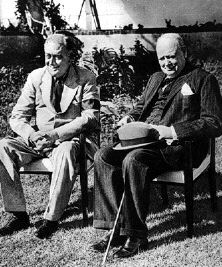Hands across the Sea
Alan Turing was a top-level link between Britain and the United States, and his visit to America between November 1942 and March 1943 was a landmark in the Intelligence collaboration that, with its continuation after 1945, has shaped the global post-war order.
The background: After Japan and Germany declared war on the United States in December 1941, the British commonwealth and empire gained a stronger ally. However, Britain had been economically dependent on American 'Lend-Lease' support since 1941, and in 1942 suffered a succession of disasters, essentially marking the end of its colonial and commercial rule in Asia. One of the few cards in the British hand was the triumph with the Enigma. But since February 1942, a small technical change in the Atlantic U-boat Enigma (the 'fourth rotor') had snatched away their success in this vital area of operations. As 1942 went on, with disastrous shipping losses, the U. S. insisted on being told everything about the Enigma. The British were reluctant, for two reasons. (1) They did not wish to give away everything they knew, without getting anything in return. (Poland had done that in 1939, and the bitterness lasts to this day.) (2) They did not trust the Americans to use the information properly. A complicating factor, which the well-co-ordinated Bletchley Park people found almost incomprehensible, was that the U. S. Navy and U. S. Army worked as independent organisations, if not indeed as mutual enemies.
| 
Roosevelt and Churchill at the Casablanca conference, January 1943
photo: U.S. National Archives |
|
Realities of power in this as in every other field obliged Britain to concede independence and try to make the most of it. British industry could not cope with making enough high-speed Bombes to cope with the 4-rotor Enigma problem, whilst American industry could. After several top-level administrative meetings in the course of 1942, which created a working agreement for the sharing of work and information on naval signals, Turing's visit to America represented the first top-level technical liaison on the cryptographic procedures.
The deal was that he would share everything he knew on Enigma. But he would also be allowed to inspect the speech encryption system being set up for Roosevelt-Churchill conversations, and so be allowed access to the most secret American work in this field. However, these agreements were poorly worked out at the time of his visit, and involved furious renegotiation at the highest levels while he was there.
There is a very clear account of these issues in
The Ultra-Magic Deals, by Bradley E. Smith (1993). Smith indicates that the furore over Turing's access to speech secrecy work was instrumental in bringing about the much more comprehensive BRUSA agreement of 1943, which effectively created the Anglo-American alliance as it has been ever since.
A remarkable historical overview of this period can be found in a
a document of the (US) National Security Agency, It Wasn't All Magic: The Early Struggle to Automate Cryptanalysis, 1930s-1960s, released in August 2012. This gives a clear account of the central role played by the British contributions, and also of the distrust between the Allies.
Turing arrived at New York on 12 November 1942, probably on the Queen Elizabeth. He had been told to carry no identifying papers, and as a result was almost refused entry. This mix-up typified the highly uneasy state of the UK-USA agreements about sharing secret material. He went first to Washington and inspected the U. S. Navy cryptanalytic department.
He was not impressed. Read:
You can see that Turing was placed in an extremely difficult position by the incomplete alliance: for instance, the British still wished to keep to themselves their growing success with the Lorenz machine (the 'Tunny' material, as discussed on the next Scrapbook page), and he did not know what he was allowed to tell the Americans.
This document was featured in BBC news when it was released by the (British) National Archives in 2004.
He was more impressed with the National Cash Register works at Dayton, Ohio, where American Bombes were being manufactured. The U. S. Navy had been able to take over enormous industrial resources, far beyond the capacity of British industry, so as to attack the Atlantic U-boat Enigma problem.
You can see how Turing was in total command of the system for deciphering the U-boat Enigma, and also showed complete confidence in engineering questions. The report helps to make it clear why in 1945 Turing thought himself well qualified to design a computer.
There is again a note of arrogance in his voice regarding American ideas, which would be consistent with what in 1946 he described as American reliance on machinery instead of thought.
It is noteworthy that Turing also seems to have been consulted over use of the (American) Hagelin cipher machine. The last paragraph also shows that while in the United States he was kept in touch with current developments back at Bletchley on the breaking of the Lorenz cipher.
|